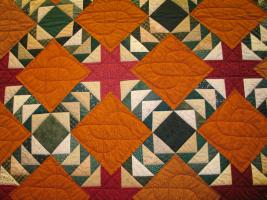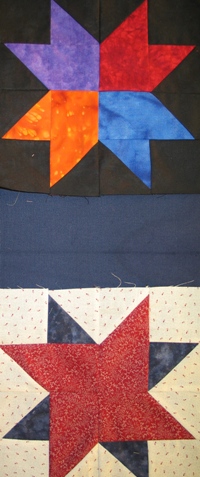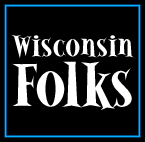|
Home | Search | The Artists | Teaching | Hiring | About This Site | Contact Us |
||

Quilts Much time and care goes into making a homemade quilt. There are many steps in the process. The word “quilt” actually refers to one of the last steps, when the quilter sews a design through the backing, batting and quilt top. What are the backing, batting, and quilt top? Those three things are the major components of a quilt. Here, we’ll show you how it works!
This picture shows an unfinished quilt of Pat’s. Click on the image to see the three layers. The top layer is called the quilt top. It has the most designed pattern. The white middle sheet is called the batting. It provides the thickness of the quilt. The bottom layer is the backing.
Designing quilts The design of a quilt—how it looks and how it is laid out—is determined by two main factors, the patterns or shapes of the fabric and the colors the quilter uses.
Pictures, scenes Some quilts have patterns. Others have pictures that tell stories.
What are quilts for? Quilts have changed in purpose and style over the generations. Sometimes quilters in earlier days used empty, animal feed sacks for their quilt top and backing. That was when the quilt’s only purpose was warmth, not decoration. Other quilters made their quilts from material that they saved from old aprons, shirts and dresses. That was when a purpose for quilts was thrift. Some quilters make quilts for the main purpose of making art. These artists choose to use fabric as their medium instead of using paint, wood, metal, or paper. An art quilt is like a painting in many ways—
Another purpose for quilts is to honor and remember. For example, in 1987 thousands of people in the United States came together to make the largest memorial quilt of all time. It was called the NAMES quilt. Each block honored a person who had died from AIDS. The NAMES quilt helps us to remember those people in a special artistic way. Whether big or small, quilts can make an impact in the lives of people. |
For Educators: |
|
|
|
||
|
Home | Search | The Artists | Teaching | Hiring | About This Site | Contact Us |
||

 Look closely at this star from Pat’s
“Millenium Quilt.” Can you see the quilting in it? All of the stitching (the
Look closely at this star from Pat’s
“Millenium Quilt.” Can you see the quilting in it? All of the stitching (the
 Quilters have
many choices to make. There are more than 4,000 different quilt patterns to choose from! The different patterns emphasize different shapes, like squares, diamonds,
circles, or rectangles. The quilting stitches can add even more shapes to a
quilt. How many different shapes can you find in this quilt by Pat?
Quilters have
many choices to make. There are more than 4,000 different quilt patterns to choose from! The different patterns emphasize different shapes, like squares, diamonds,
circles, or rectangles. The quilting stitches can add even more shapes to a
quilt. How many different shapes can you find in this quilt by Pat?  The colors a quilter uses for each part of the pattern make a huge difference in how the quilt looks.
See this example? These two blocks use the same pattern but different color
use makes them look very different. When Pat teaches her students how to quilt, she often has them make quilts that use the
same pattern but different colors. This helps them learn how color affects
quilt design.
The colors a quilter uses for each part of the pattern make a huge difference in how the quilt looks.
See this example? These two blocks use the same pattern but different color
use makes them look very different. When Pat teaches her students how to quilt, she often has them make quilts that use the
same pattern but different colors. This helps them learn how color affects
quilt design.
 One time, Pat did a quilt for a project that had a theme — puzzles. Pat made her ‘puzzling’
quilt about the question, “Which came first, the chicken or the egg?”
One time, Pat did a quilt for a project that had a theme — puzzles. Pat made her ‘puzzling’
quilt about the question, “Which came first, the chicken or the egg?” 